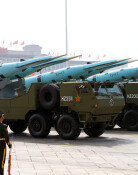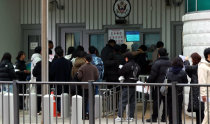Killed in Action
A senior military diver died yesterday while undergoing treatment after fainting in a search and rescue operation at the site of the sunken patrol boat Cheonan. He died while carrying out the challenging mission along with his colleagues amid a tough environment, including rapid underwater currents and high aquatic pressure. The rescue operation was a do-or-die battle staged on Full Moon Day, when currents are the fastest in a given month. His death is truly saddening and painful to all. May he rest in peace after his struggle to save his naval comrades.
Rescuers have continued dangerous work that put their lives at risk, but have failed repeatedly in their bids to enter the stern of the Cheonan due to swift currents and aquatic resistance 14 times as strong as atmospheric pressure. Two military divers fainted due to high aquatic pressure. A commander on the rescue team said, The water currents here are three to four nautical miles, and we feel like were standing on top of a building amid a typhoon.
Members of the Navys underwater demolition team and ship salvage units continued diving at risk of death around the Gwangyang vessel, with the site lit as bright as daylight. The night sea illuminated by intense lighting was incredibly calm. Even if the servicemen wore thick winter jackets, they were feeling the cold in their fingers. They would have felt much colder underwater. Though the maximum survival time for the missing crew members of the Cheonan has passed, rescuers apparently want to continue their rescue mission.
The stern was found about 300 meters away from the original site of the sinking. The section is believed to have rolled over several times because of tides. Had I been contained in the vessel, could I endure solitude, freezing temperatures, starvation and thirst? The bereaved families of the missing and fellow servicemen are sobbing, but those inside the vessel have no energy left to sob.
The sea by day was streaming and waving like a river flooding due to torrential rain. The underwater demolition team and the ship salvage unit conducted rescue operations by tying their rubber boats with ropes from the Gwangyang. This ship is surrounded by the military ships Dokdo, Seonginbong and Sokcho. In the skies flew the naval choppers Chinook and Links, the Puma choppers of the Korea Coast Guard, and HH-60 choppers of the Air Force.
About 6.5 kilometers off to the east lies the sunken bow of the Cheonan. The mine sweeping vessel Ongjin and members of the underwater demolition team aboard rubber boats in charge of mine removal searched for mines due to the areas close proximity to North Korean waters. External sections of the area were patrolled by rubber boats of the Marines special reconnaissance unit. Seagulls that flew in shore cliffs sang aimlessly.
Giving words of encouragement aboard the Dokdo to seamen, President Lee Myung-bak said, I think Navy servicemen deployed at the Northern Limit Line, the inter-Korean border, are like those who fight on a battlefield in a war. The country must recognize them and treat them the same as it does for soldiers killed in action for the nation in dangerous areas of the frontier. Families of those who remain missing had a glimmer of hope after the inspection of the stern discovered three days ago and nervously awaited the safe return of their loved ones. They are now completely exhausted, however. A growing number of bereaved relatives have fainted and have been hospitalized. They have barely slept or ate. The South Korean public, which have nervously and vigilantly watched the rescue efforts, anxiously hope for a miraculous rescue of the missing servicemen.







